
scrounge: /skrounj/ informal verb: to actively seek [books] from any available source
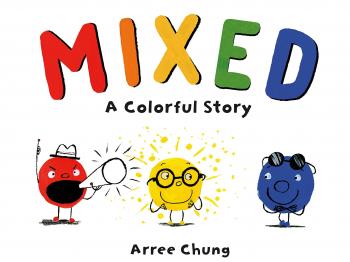
On the surface, Mixed looks like a book about mixing colors. I'd been looking for something like this that would give kids a visual of primary/secondary colors, and I thought it would be great if it was told in a story format to make things more interesting.
Turns out this story does involve mixing colors, but it has a lot more going on and I really like how the deeper issue was portrayed through a relatively simple story. With descriptive but succinct text, the narrative begins with three color populations living together in a city, who soon decide to live apart after an argument about which one is better. Each color keeps their distinctive traits sequestered in their own part of the city, until one day a blue and a yellow meet, fall in love, and decide to... *gulp*... mix!
So while it's about art, it's also about racism, and could probably be applied to many other distinctives that have become ways by which people have tried to assert superiority over others. Perhaps it's oversimplified, but for a short and sweet fable, I though it worked really well, and didn't feel heavy-handed to me.
Scrounged From: Our local library
Format: Hardcover
Author/Illustrator: Arree Chung
Pages: 40
Content Advisory: None
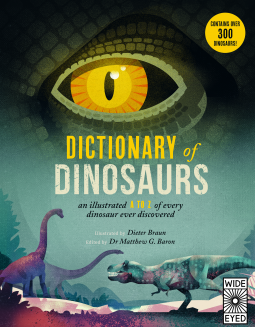
Dictionary of Dinosaurs is a really neat collection that lists all the dinosaurs discovered up to this point. Length, diet, and when/where the animal lived are provided for each dinosaur, as well as a name pronounciation guide (very helpful!) and the meaning of the name, some of which are very interesting. I learned that there is a dinosaur whose name was inspired by Lewis Carroll's Jabberwocky poem (borogovia)!
On each page, a dinosaur or two (but not all of them) are highlighted with a color picture, a blurb of information, and a silhouetted picture comparing the dinosaur's size to that of a human. Most of the more well-known dinosaurs (tyrannosaurus, stegosaurus) are highlighted this way. Since marine reptiles and flying reptiles are no longer considered "dinosaurs" (something that apparently happened between when I was a kid and when I had kids old enough to like dinosaurs), they are unfortunately not included in this book.
In the beginning of the book is some general information about time periods, fossils, etc., but I found this statement interesting:
"New information about dinosaurs is being discovered all the time. Dinosaurs often change name, or their dates change once more information is found out about them. This means it's a very exciting field to get into and learn about. You could even discover or name the next dinosaur one day!"
In other places, the book notes that certain dinosaurs may not actually be separate species, but scientists made the best guess they could based on the evidence. I really like the way this portrays science as an ongoing effort rather than a static collection of information.
As is obvious from the title, this isn't likely the kind of book you'd want to sit down and read all in one sitting, but it's a great reference for dinosaur-loving kids, full of colorful pictures and current information -- for now!
(Thanks to NetGalley for the review copy.)
Scrounged From: NetGalley
Format: Kindle
Author: Matthew G. Baron
Illustrator: Dieter Braun
Pages: 184
Content Advisory: None
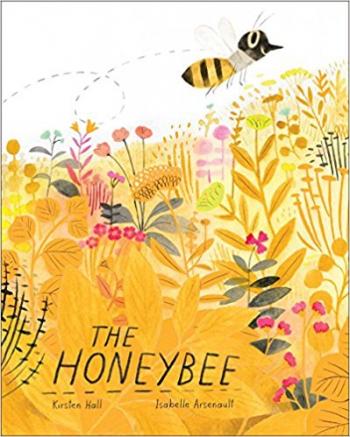
At first I wasn't sure whether The Honeybee might be a little too cartoonish for my tastes, and it's true that the bees are depicted in a whimsical way, but I ended up really enjoying this book for several reasons:
1. Isabelle Arsenault's illustrations. I'm not the only one who's now on a quest to read all of her books, but after this and You Belong Here, I adore the way she portrays nature, especially here with the lovely balance of colors, and the bright shades of gold which are vibrant without being garish.
2. While the bees are given faces and look a bit cutesy, this book still aims to be accurate in its depiction of how bees spend their lives, from foraging to making honey to dancing, and more. This book would work great for a science unit on bees, perhaps along with Charlotte Milner's more fact-laden The Bee Book.
3. The text is poetic rather than straight narrative, but it also retains enough structure (such as rhyme) and focus to tell the story of bees in a linear, engaging way. There are so many action words here that even the text itself seems buzzing with the exuberance and busyness of the bees.
Scrounged From: Our local library
Format: Hardcover
Author: Kirsten Hall
Illustrator: Isabelle Arsenault
Pages: 48
Content Advisory: None
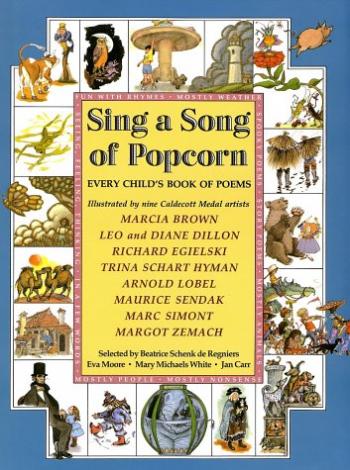
When I was approaching adulthood, there were times when I really didn't care that much for poetry. I felt like I didn't "get" many adult poems, and didn't really seek out reading them. I developed more appreciation for poetry in college, but this volume of poetry has helped remind me that I also appreciated poetry at a younger age.
Sing a Song of Popcorn was published when I was a toddler, and is a collection of poetry for children in which each section is illustrated by a different illustrator, including such well-known names as Arnold Lobel, Maurice Sendak, and Marc Simont. Each section includes a different topic of poetry, such as weather, animals, people, story poems, and more. As a child, I think the "Mostly Nonsense" section was my favorite, as it featured favorites such as "Eletelephony" by Laura E. Richards (I grew up a few miles from the elementary school named after her) and some limericks. I like how the different illustrators all have their own distinctive style.
Other authors include: A. A. Milne, Robert Louis Stevenson, Robert Frost (I originally memorized "Stopping by Woods on a Snowy Evening" from this book), Ogden Nash, Edna St. Vincent Millay, and many more.
I've been glad to see my kids enjoying this book and picking out poems for me to read to them. Like me at the time, they are more drawn to the silly ones and not as much to some of the more abstract ones at the end (the "Seeing, Feeling, Thinking" section) -- but I enjoy those more now, so I think there's something here for everyone.
Scrounged From: A family gift as a child, and in a box of used books from my sister-in-law as an adult
Format: Hardcover
Author/Illustrator: Various
Pages: 160
Content Advisory: There is a section of "spooky" poems, some of which involve witches and ghosts, and the poem "Isabel" involves the protagonist cutting a giant's head off.
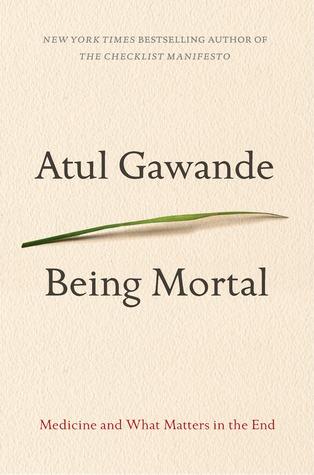
Being Mortal: Medicine and What Matters in the End was such a much-needed look at how the medical system treats death. I had wondered whether it would be depressing to read, and there were certainly sad moments and stories, but it was also hopeful and uplifting, and I found myself losing track of time while reading it sometimes. Even when statistics and information are provided, the narrative moves smoothly enough into stories and commentary to not get bogged down.
Gawande traces some of the history of the way humans have treated end-of-life care, emphasizing the advent of the nursing home, as well as "assisted living" and other attempts to bridge the gap between the hospital and the home. He also includes the stories of the (non-elderly) terminally ill as he explores the questions of what people who are dying really need -- and how we even get to the point where we are able to recognize "dying" for what it is, when we try to stave off death at any cost. He says:
“The problem with medicine and the institutions it has spawned for the care of the sick and the old is not that they have had an incorrect view of what makes life significant. The problem is that they have had almost no view at all. Medicine’s focus is narrow. Medical professionals concentrate on repair of health, not sustenance of the soul. Yet—and this is the painful paradox—we have decided that they should be the ones who largely define how we live in our waning days.”
He contrasts the traditional attitude of medicine, which is to solve problems and offer as much information and possibilities as it can, with the type of care (hospice) that looks to instead focus on the here and now rather than sacrificing the "now" for slim and unlikely future gains for the elderly and terminally ill -- but as he illustrates, it can be very difficult to draw that line.
There were so many eye-opening things to think about here. This is a book that will probably resonate with many people -- even those of us who are not elderly or terminally ill have loved ones who are or will be, and it's worth thinking about what is most important during that journey, and developing a little bit of preparation for difficult conversations that will inevitably happen.
Scrounged From: A local used book sale.
Format: Hardcover
Author: Atul Gawande
Pages: 282
Content Advisory: Naturally, in a book that discusses death, there are many descriptions of people who are aging and dying, as well as some descriptions of their ailments and medical procedures. As I said, some of these are very sad, but the tone of the book overall is uplifting. Other than that, I remember a few minor swear words, but nothing else that I'd consider objectionable. Gawande does briefly mention "assisted death" toward the end, but that's not what the book is about. While he doesn't appear to be opposed to the idea, he also critiques it, and emphasizes that this attitude leaves us in danger of not valuing "assisted living" enough.

